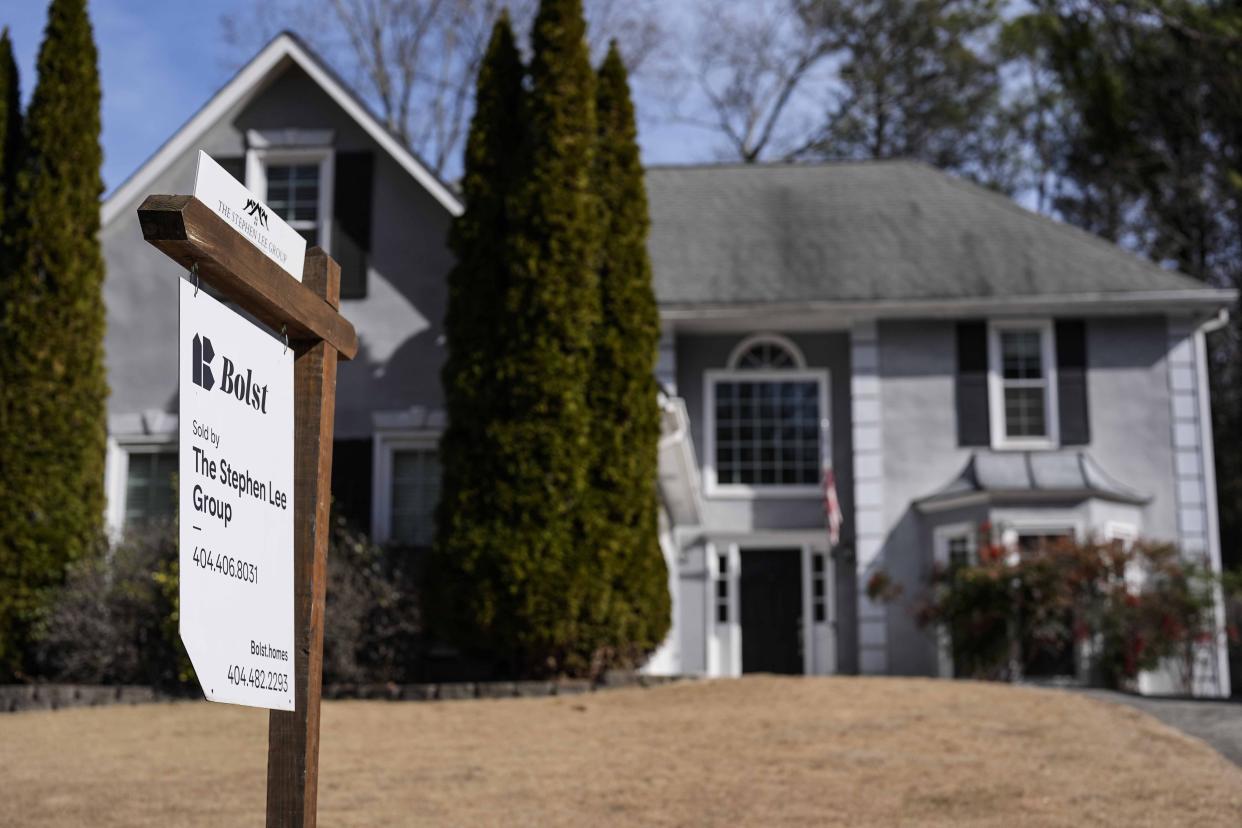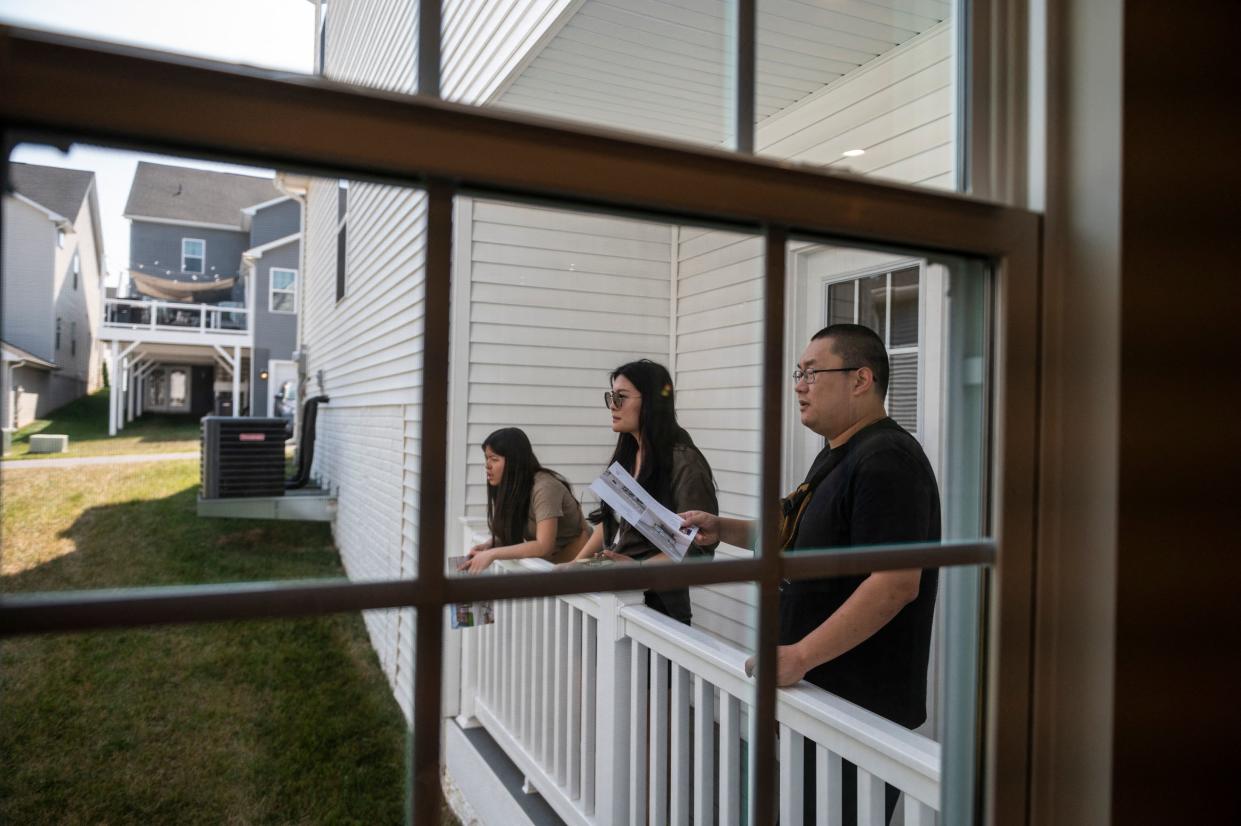Mortgage refinance demand spikes as rates fall for second straight week
More homeowners raced to refinance this week as mortgage rates continued to pull away from 7%, but that window of opportunity may close soon.
The average rate on the 30-year fixed mortgage fell to 6.74% from 6.88% the week prior, according to Freddie Mac. Rates have now fallen nearly a quarter of a percent in just two weeks, a positive for rate-sensitive borrowers on the sidelines.
The easing in rates gave some homeowners what they have long been waiting for: a chance to refinance, either to seek a lower mortgage payment or clear off other debts. Still, with inflation still coming in hotter than expected this week, all signs point to rates tilting higher in the weeks to come.
“In the short-term, mortgage rates are probably not going to fall much further this month,” said Lisa Sturtevant, chief economist at Bright MLS. “But it is all relative. Rates are much lower than they were last fall when they hovered near 8%. Any downward trend in rates later this spring will bring more buyers — and sellers — into the market.”
Read more: Is it time to refinance your mortgage? 5 ways to prepare.
Those who purchased at peak rates look to refinance
As mortgage rates continued to pull away from the 7% mark, homeowners waiting for an opportunity to refinance didn’t think twice.
The volume of refinance applications increased 12% for the week ending March 8 and was 5% above year-ago levels. According to the Mortgage Bankers Association (MBA) weekly survey of applications, the sudden jump in refi activity was led by a larger 24% increase in the government refinance index.
Demand for refinancing began picking up at the start of March, an indication that new homeowners are closely attuned to rate movements and ready to grab whatever relief they can.
Still, those who can benefit from refinancing in today’s market are few. Some 89% of homeowners with a mortgage carried a rate under 6% as of January, according to Redfin, leaving a slim share who could potentially benefit from a lower rate.
“While these percentage increases are large, the level of refinance activity remains quite low,” said Mike Fratantoni, chief economist for the MBA. “We expect that most of this activity reflects borrowers who took out a loan at or near the peak of rates in the past two years.”
Even so, folks who purchased at the peak in October — when rates were nearly 8% — could get some relief in their budgets by refinancing today.
Read more: Mortgage rates fall below 7% — is this a good time to buy a house?

For instance, someone who purchased a home for $375,000, at a 30-year fixed rate of 7.79% in October would be shouldering a monthly payment of roughly $3,082, including taxes and fees. That’s after offering a down payment of at least 10% in New York. Meanwhile, if that same buyer refinanced at a rate of 6.88%, their monthly payment would dip to $2,873.
The jump in refinance activity, however, may be short-lived as some experts expect rates to swing back in upcoming weeks.
“After reports that inflation ticked up in February and the labor market continued to show signs of resiliency, it is more certain that the Fed will not cut interest rates at its meeting later this month,” Sturtevant said. “Instead, look for the first rate cut to come at the Fed’s June or July meeting. As a result, mortgage rates will stay elevated.”
Some homeowners are refinancing to dig themselves out of debt
Some of the recent uptick in refinancing is homeowners looking to reduce their debt.
“Tomorrow, I close on a loan where the interest rate will double,” Jason Sharon, owner of Home Loans Inc. told Yahoo Finance. “No joke, go from 3% to 6%. On the surface, that seems like a horrible idea. However, they are paying off a tremendous amount of debt.”
According to Sharon, his client will save approximately $1,000 per month in total debt payments, despite taking on a larger mortgage payment. What’s more, if the client opted to pay that $1,000 saved toward the new mortgage, they would pay off the new higher rate loan in just 12 years.
“That is a life-altering decision, which initially seems counterintuitive to the bone,” said Sharon.
One common financial burden Sharon has seen among clients is climbing credit card debt, which has risen to its highest point in decades.
Credit card balances rose by $50 billion to a record-shattering $1.13 trillion at the end of last year, according to the Federal Reserve Bank of New York, and it’s still climbing. Credit card and auto loan delinquencies were also on the rise, particularly among younger and lower-income households.
Read more: The best ways to pay off credit card debt

To ease those strains, some homeowners are giving up some of their gained equity to refinance.
According to CoreLogic, US homeowners with mortgages — representing nearly 62% of all properties — saw their equity increase by a total of $1.3 trillion since the fourth quarter of 2022, a gain of 8.6% year over year.
“We have a record amount of credit card debt in America; we also have a record amount of home equity. So many Americans are doing a refi to pay off that debt even though it's raising their mortgage interest rate,” Sharon said. “It is people that have too much money left at the end of the month.”
Nationwide, the average homeowner gained approximately $24,000 in equity in 2023 alone, CoreLogic found. Residents of Rhode Island, New Jersey, and Massachusetts saw the largest equity gains, all averaging $50,000 or more, the study found.
With overall debt rising and inflation still hot, there could be more homeowners considering refinancing this year — despite elevated rates in the housing market.
Sharon added: “It’s also a combination of a large amount of high interest rate consumer debt that has families leveraging their home equity to get some breathing room at the end of the month.”
Gabriella Cruz-Martinez is a personal finance and housing reporter at Yahoo Finance. Follow her on X @__gabriellacruz.
